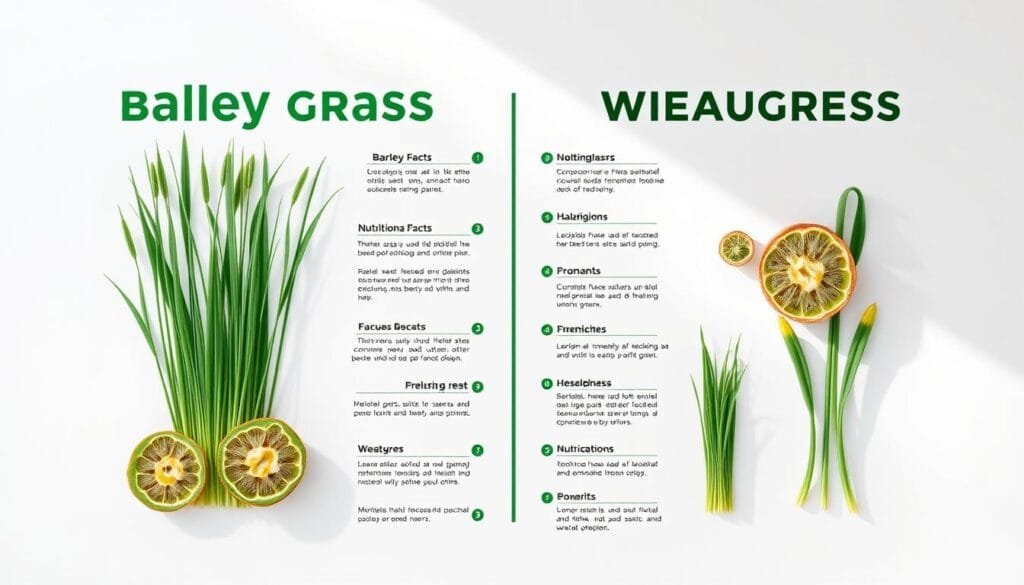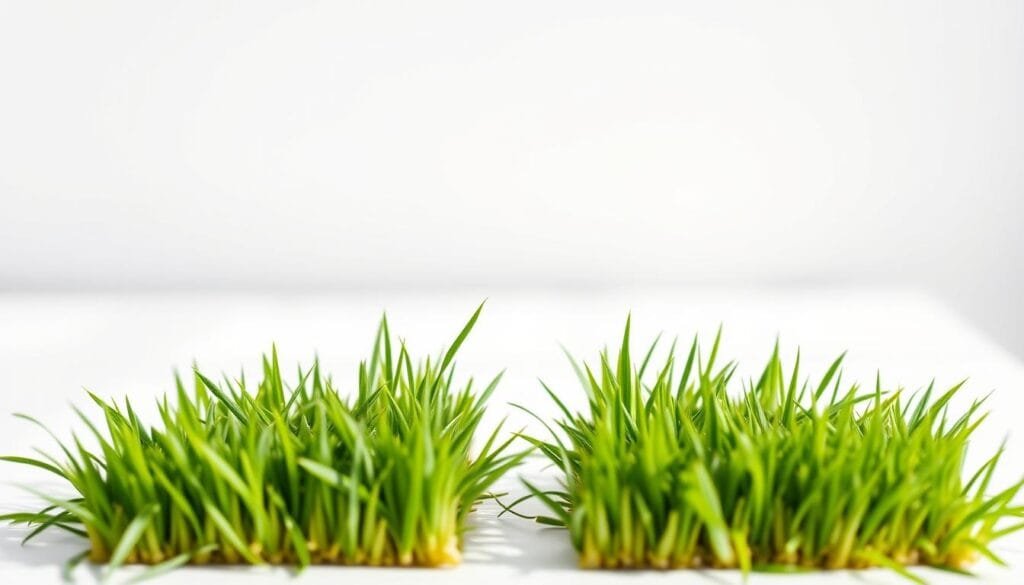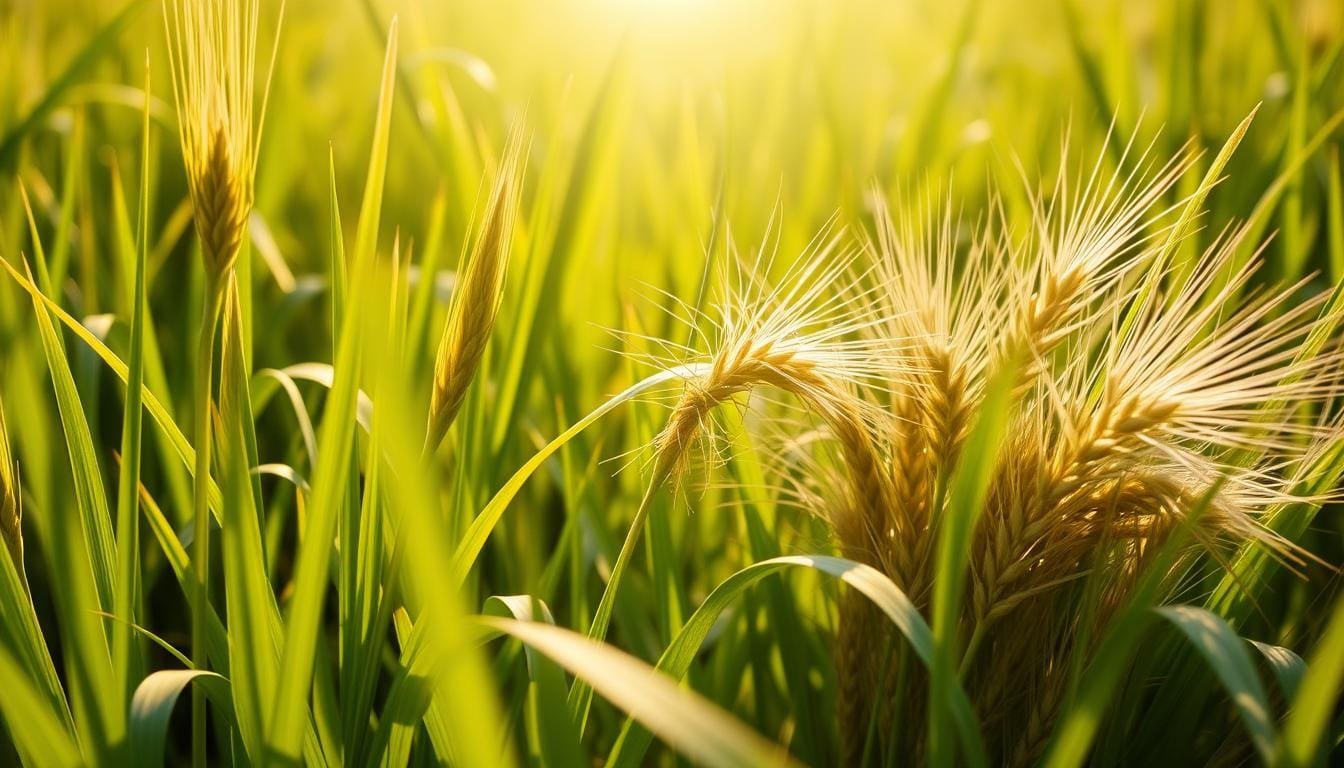Currently Empty: RM0.00
Are you confused about whether barley grass or wheatgrass is the better choice for boosting your health? Both are popular superfoods in Malaysia, known for their rich nutritional profiles and numerous benefits. But what sets them apart?
Wellness Concept explores the unique qualities of these young grasses, harvested from barley and wheat plants, respectively. Rich in antioxidants and chlorophyll, they offer various health advantages. Understanding their differences is key to making an informed decision about which one suits your needs.
Key Takeaways
- Understand the nutritional differences between barley grass and wheatgrass.
- Learn about the specific health benefits associated with each superfood.
- Discover how to incorporate these nutrient-dense foods into your diet.
- Find out which one might be better suited for your personal health goals.
- Get tips on sourcing high-quality barley grass and wheatgrass products in Malaysia.
Understanding Superfoods: Barley Grass and Wheatgrass
Young cereal grasses, particularly barley grass and wheatgrass, have been recognized for their medicinal properties for thousands of years. These grasses are derived from the early stages of plant growth, before they mature into the grains commonly used in food production.
What Are Young Cereal Grasses?
Barley grass is the young leaf of the barley plant Hordeum vulgare, while wheatgrass is the young sprout of the wheat plant Triticum aestivum. Both are considered nutritional powerhouses due to their high content of vitamins, minerals, and antioxidants. The use of these young grasses for health purposes dates back to ancient civilizations, which valued their potential to promote overall well-being.
History and Origin of These Superfoods
The history of using young cereal grasses for health benefits stretches back over 10,000 years, with barley being one of the oldest cultivated grains. Barley grass was utilized in traditional medicine across Asia, while wheatgrass gained popularity in the West during the 1930s through the work of agricultural chemist Charles Schnabel. In Malaysia, various grass extracts have been used historically for their healing properties, with barley and wheat grasses being more recent additions to the health trend. For more information on the health benefits of barley grass, you can visit Wellness Concept’s blog on barley grass health.
Nutritional Profiles: What’s Inside These Green Powerhouses
Delving into the nutritional profiles of barley grass and wheatgrass reveals their potential as green superfoods. Both are rich in essential vitamins, minerals, and other beneficial compounds.
Barley Grass Nutritional Composition
Barley grass is a nutrient-dense food, rich in antioxidants and containing a significant amount of chlorophyll, which is known for its detoxifying properties. It is also a good source of vitamins and minerals, including vitamins A, C, and E, and minerals like iron and calcium. The presence of amino acids in barley grass contributes to its nutritional value, supporting overall health.
Wheatgrass Nutritional Breakdown
Wheatgrass is particularly notable for its high nutrient density, including vitamins A, C, and E, and essential minerals such as iron, magnesium, and calcium. It contains all eight essential amino acids, making it a complete protein source. Wheatgrass is also rich in chlorophyll and antioxidants, including superoxide dismutase (SOD), which helps combat oxidative stress.
- Wheatgrass has a higher protein content compared to barley grass, with approximately 28g of protein per 100g.
- It is rich in vitamins and minerals in bioavailable forms, supporting overall health and wellness.
- The presence of active enzymes in wheatgrass aids in digestion and nutrient absorption.
Both barley grass and wheatgrass offer unique nutritional profiles that can support a healthy diet. Understanding their compositions can help individuals make informed choices about incorporating these superfoods into their wellness routines.
Barley Grass vs. Wheatgrass Benefits: A Comparative Guide for Malaysians
For Malaysians delving into the world of green supplements, distinguishing between the benefits of barley grass and wheatgrass is essential. Both are considered superfoods due to their high nutritional value and potential health benefits.
Shared Health Benefits
Both barley grass and wheatgrass offer numerous health benefits, including high antioxidant content, potential anti-inflammatory properties, and the ability to support overall well-being. They are rich in vitamins, minerals, and enzymes that can help protect against various health issues.
The antioxidant properties in both grasses can help combat oxidative stress, a condition that can lead to chronic diseases and premature aging. By incorporating either or both into their diet, Malaysians can potentially enhance their health and vitality.
Unique Benefits of Barley Grass
Barley grass is notable for its nutritional profile, which includes a range of vitamins and minerals. While it contains superoxide dismutase (SOD), an enzyme that helps counter oxidative stress, its levels are lower compared to wheatgrass, with 146,000 units per 100g.
Unique Benefits of Wheatgrass
Wheatgrass stands out due to its exceptionally high SOD content, boasting 303,000 units per 100g, making it potentially more effective at neutralizing harmful free radicals and reducing oxidative stress. Additionally, wheatgrass contains a higher protein content (28g per 100g), which is beneficial for muscle recovery and tissue repair, especially for physically active individuals.
Research suggests that wheatgrass may be more effective at supporting healthy red blood cell production and reducing inflammation, thanks to its unique enzyme profile. This makes it particularly appealing for those looking to address anemia or fatigue issues.
In conclusion, while both barley grass and wheatgrass offer a range of health benefits, their unique properties cater to different needs. Understanding these differences can help Malaysians make informed decisions about which superfood to incorporate into their health regimen.
Alkalizing Properties and Detoxification Potential
Understanding the alkalizing effects and detoxifying capabilities of barley grass and wheatgrass is crucial for Malaysians looking to enhance their well-being. These superfoods have been recognized for their potential to balance body pH and support the body’s natural detoxification processes.
How These Grasses Help Balance Body pH
The high chlorophyll content in both barley grass and wheatgrass contributes to their alkalizing properties. Chlorophyll helps neutralize acidity in the body, promoting a more alkaline environment. This is particularly beneficial as an acidic body pH can lead to various health issues. By consuming these grasses, individuals can help maintain a healthier pH balance.
Detoxifying Effects on the Body
The detoxifying effects of barley grass and wheatgrass are largely attributed to their chlorophyll content. Chlorophyll acts as a powerful detoxifying agent, binding to heavy metals and environmental toxins to facilitate their removal from the body. Wheatgrass, with its slightly higher chlorophyll content compared to barley grass, may be more effective for intensive detoxification protocols. Regular consumption of these grasses supports liver and kidney function, enhancing the body’s natural elimination processes.
| Benefit | Barley Grass | Wheatgrass |
|---|---|---|
| Chlorophyll Content | High | Slightly Higher |
| Detoxification Potential | Effective | More Effective |
| Alkalizing Effect | Present | Present |
For those interested in incorporating these superfoods into their diet, visiting a reputable source like Wellness Concept can provide valuable insights into high-quality barley grass supplements.

Digestibility and Taste Differences
When it comes to incorporating superfoods like barley grass and wheatgrass into your diet, understanding their digestibility and taste differences is crucial. Both are nutrient-dense foods that can offer significant health benefits, but their impact on the body can vary based on individual tolerance and digestive health.
Flavor Profiles Compared
The taste of barley grass and wheatgrass can be a significant factor in choosing between them. Barley grass is often described as having a milder, slightly sweet flavor, while wheatgrass has a stronger, more earthy taste. For those who are sensitive to strong flavors, barley grass might be more palatable. However, some individuals prefer the robust taste of wheatgrass, finding it invigorating.
Digestive Comfort and Considerations
Digestive comfort is another critical aspect to consider. Barley grass is generally considered gentler on the digestive system than wheatgrass, making it a better starting point for those new to cereal grass supplements. The higher fiber content in barley grass supports digestive comfort by promoting regular bowel movements and feeding beneficial gut bacteria. In contrast, some individuals may experience nausea, headaches, or diarrhea when they first start consuming wheatgrass, especially in large amounts.
“Starting with a small amount and gradually increasing it to the recommended dosage can help mitigate these symptoms.”
Experts recommend this gradual approach to allow the body’sdigestive systemto adapt to these nutrient-dense foods.
Ultimately, the choice between barley grass and wheatgrass should be based on individual tolerance, digestive needs, and personal preference regarding taste.
How to Incorporate These Superfoods Into Your Malaysian Diet

Barley grass and wheatgrass are versatile superfoods that can be easily incorporated into various Malaysian dishes. Both can be consumed in various forms, including fresh juice, powders, capsules, or even as part of super greens powders. This flexibility makes it simple for Malaysians to add these nutrient-dense foods to their daily routines.
Popular Consumption Methods
Malaysians can enjoy barley grass and wheatgrass in several ways. They can be blended into smoothies with local fruits, added to traditional soups, or consumed as a refreshing juice. The greens powders can also be mixed into beverages like teh tarik or coffee for an antioxidant boost.
The versatility of these superfoods allows for various consumption methods, making it easy to incorporate them into daily life. Whether you prefer a quick juice or adding greens powder to your favorite recipes, there are numerous ways to enjoy the benefits of barley grass and wheatgrass.
Recipe Ideas with Malaysian Flavors
Creating delicious and healthy recipes with barley grass and wheatgrass is easy. For example, you can make a tropical Malaysian smoothie by blending either grass powder with mangosteen, rambutan, or dragon fruit. Adding a teaspoon of either grass powder to your morning coffee or teh tarik can provide an antioxidant boost. You can also incorporate these greens into traditional Malaysian dishes like sayur lodeh or curry laksa, or create refreshing ice popsicles by blending the grass with coconut water, lime juice, and a touch of honey.
Choosing the Right Option for Your Health Needs
Selecting the right grass supplement can be challenging without knowing the key differences between barley grass and wheatgrass. Both offer numerous health benefits, but certain characteristics make one more suitable than the other depending on individual health needs.
When to Choose Barley Grass
Barley grass is a nutrient-rich supplement that provides various health benefits. While it may not excel in certain nutritional aspects compared to wheatgrass, it still offers a robust profile that can cater to general health and wellness needs.
For those looking for a more balanced nutrient profile, barley grass might be the preferred choice. However, specific health goals or dietary requirements might make wheatgrass more appealing.
When Wheatgrass Might Be Better
Wheatgrass has several advantages that make it a superior choice for certain individuals. It contains more protein (28g per 100g) compared to barley grass (22.1g per 100g), making it ideal for those focused on building muscle or increasing protein intake.
| Nutritional Component | Barley Grass (per 100g) | Wheatgrass (per 100g) |
|---|---|---|
| Protein | 22.1g | 28.0g |
| Carbohydrates | 8.0g | 4.9g |
| Superoxide Dismutase (SOD) | 146,000 units | 303,000 units |
Athletes and highly active individuals may benefit more from wheatgrass due to its higher concentration of superoxide dismutase (SOD), which helps reduce exercise-induced oxidative stress and supports faster recovery. Those following low-carbohydrate diets should also consider wheatgrass as their primary grass supplement.

Availability and Quality Considerations in Malaysia
As interest in superfoods grows in Malaysia, finding reliable sources for barley grass and wheatgrass becomes increasingly important. Consumers can now find these products in various health stores, online marketplaces, and specialty nutrition shops.
Finding High-Quality Products
When searching for barley grass and wheatgrass products, it’s essential to focus on quality. Look for products that are certified organic and have undergone rigorous testing for purity and potency. Brands like Wellness Concept are known for their high-quality grass supplements.
Wellness Concept: Your Source for Premium Grass Supplements
For those seeking high-quality barley grass and wheatgrass supplements, Wellness Concept stands out as a premier destination in Malaysia. With a commitment to providing exceptional products and services, Wellness Concept has established itself as a trusted brand in the health and wellness industry.
About Wellness Concept
Wellness Concept is dedicated to offering a comprehensive range of barley grass and wheatgrass supplements in various forms, catering to diverse customer preferences. Their product line includes organic powders, tablets, capsules, and convenient single-serve sachets, ensuring that customers can easily incorporate these superfoods into their daily routines.
Product Range and Services
The company’s product range is designed to meet different health needs, featuring both pure single-grass supplements and specialized blends that combine the benefits of barley grass and wheatgrass with other complementary superfoods. Wellness Concept also provides valuable services, including free consultations to help customers choose the most suitable supplement based on their health goals and lifestyle.
To ensure the highest quality, all supplements undergo rigorous testing for purity, potency, and contaminants. Certificates of analysis are available upon request, providing customers with peace of mind regarding the safety and efficacy of the products.
| Product Form | Description | Benefits |
|---|---|---|
| Organic Powders | Raw, unprocessed barley and wheatgrass powders | High in nutrients, versatile for various recipes |
| Tablets/Capsules | Convenient, measured doses of grass supplements | Ease of consumption, precise dosage |
| Single-serve Sachets | Portable, pre-measured packets for on-the-go nutrition | Convenient, no preparation needed |
Wellness Concept offers convenient delivery services throughout Malaysia, with flexible subscription options that ensure customers never run out of their essential grass supplements. This commitment to customer satisfaction and quality products positions Wellness Concept as a leader in the Malaysian health supplement market.
Conclusion: Making the Right Choice for Your Wellness Journey
Choosing between barley grass and wheatgrass depends on individual wellness goals and preferences. Both offer remarkable health benefits, but the right choice depends on specific needs, taste preferences, and digestive sensitivities.
For those new to green superfoods or with sensitive digestive systems, starting with barley grass is recommended. As the body adapts, exploring wheatgrass or combining both can provide a comprehensive spectrum of nutrients.
Consistency is key to experiencing the full benefits of these superfoods. Incorporating them into your daily routine yields better results than occasional use. For personalized guidance, contact Wellness Concept at +60123822655 to make the right choice for your wellness journey.
By making an informed choice, you can harness the power of these green superfoods to enhance your overall health and wellness.
What are the main differences between barley grass and wheatgrass?
Barley grass and wheatgrass are both nutrient-dense superfoods, but they have distinct nutritional profiles and benefits. Barley grass contains more antioxidants and has a higher superoxide dismutase content, while wheatgrass is rich in chlorophyll and has a stronger detoxifying effect.
Can I consume barley grass and wheatgrass together?
Yes, you can consume both barley grass and wheatgrass together, but it’s essential to start with small amounts to assess your body’s tolerance. Some people may experience digestive discomfort when consuming large quantities of these grasses.
How do I choose between barley grass and wheatgrass for my health needs?
Consider your specific health goals and needs. If you’re looking for antioxidant properties and immune system support, barley grass might be the better choice. If you need help with detoxification and alkalizing your body, wheatgrass could be more suitable.
Are barley grass and wheatgrass suitable for people with dietary restrictions?
Both barley grass and wheatgrass are generally considered gluten-free, but it’s crucial to ensure that the products you choose are processed in a gluten-free environment. Additionally, some products may be vegan-friendly, while others might not be, so it’s essential to check the ingredients and manufacturing process.
How can I incorporate barley grass and wheatgrass into my Malaysian diet?
You can add barley grass and wheatgrass powders to your favorite smoothies, juices, or desserts. You can also mix them with water or other beverages as a quick nutritional boost. Experiment with different recipes, such as Malaysian-inspired dishes, to find enjoyable ways to consume these superfoods.
What is the recommended daily intake of barley grass and wheatgrass?
The recommended daily intake varies depending on individual needs and health goals. Typically, a serving size of 1-2 teaspoons (3-6 grams) per day is considered a good starting point. However, it’s best to consult with a healthcare professional to determine the optimal dosage for your specific needs.



